I. What are the Outside Controls of the Digestive System
We’ve already discussed the various organs, cells, and enzymes involved in digestion. Now we need to get into our final topic — how is the process of digestion actually regulated so that we digest at the correct and appropriate times!
Luckily, this article will hopefully be a mix of review materials while also learning some new things about digestion regulation! Let’s get started and talk about how digestion is controlled at the level of hormonal and nervous system control!
II. Hormonal and Nervous Control of the Digestive System
As we mentioned above, digestion is primarily controlled and maintained at 2 main levels: the hormonal level and the nervous system level. Let’s go ahead and talk more about how they work to regulate digestion.
A. Hormonal Control
While it may seem like an afterthought, there are actually endocrine cells (called enteroendocrine cells) within the GI epithelium which secrete hormones to aid in the regulation of digestion! The main ones we’ll discuss are gastrin, secretin, cholecystokinin, and somatostatin.
I. Gastrin
This hormone is actually the first one to act as it functions primarily to increase digestion at the level of the stomach.
When released, gastrin works to increase the release of HCl via the parietal cells to promote acidic digestion at the stomach as well as increase the release of pepsinogen — the main gastric digestive enzyme — via the chief cells.
Gastrin is released by G cells located within the stomach with its release being stimulated by distention of the stomach and the presence of amino acids and peptides within the stomach — note how these all indicate food has been ingested and entered the stomach.
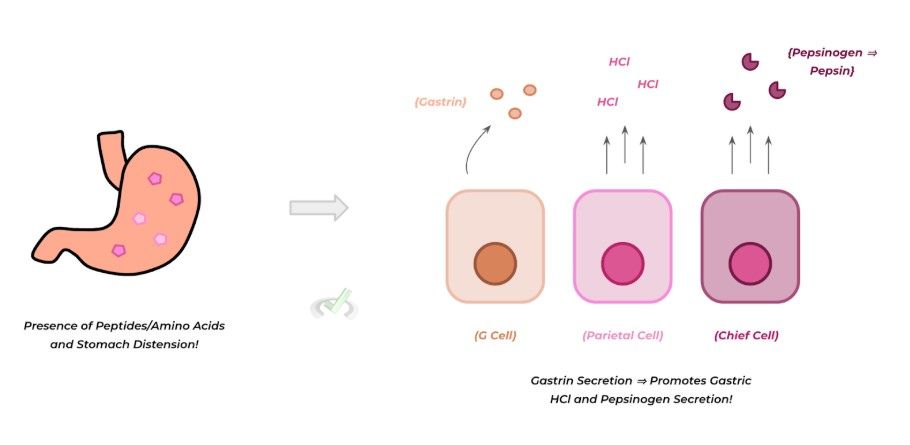
II. Secretin
After gastric digestion is complete, food from the stomach enters into the small intestine — similarly, the increased small intestinal distention due to incoming food as well as the acidic pH triggers the release of another GI hormone called secretin.
Secretin produced and secreted by the S cells located within the duodenum and will primarily result in the increased release of bicarbonate HCO3- into the small intestine as well as inhibit H+ secretion at the stomach.
This is because a majority of the digestive enzymes within the small intestine need to have an alkaline pH in order to function properly such as trypsin, chymotrypsin, lipases, etc.
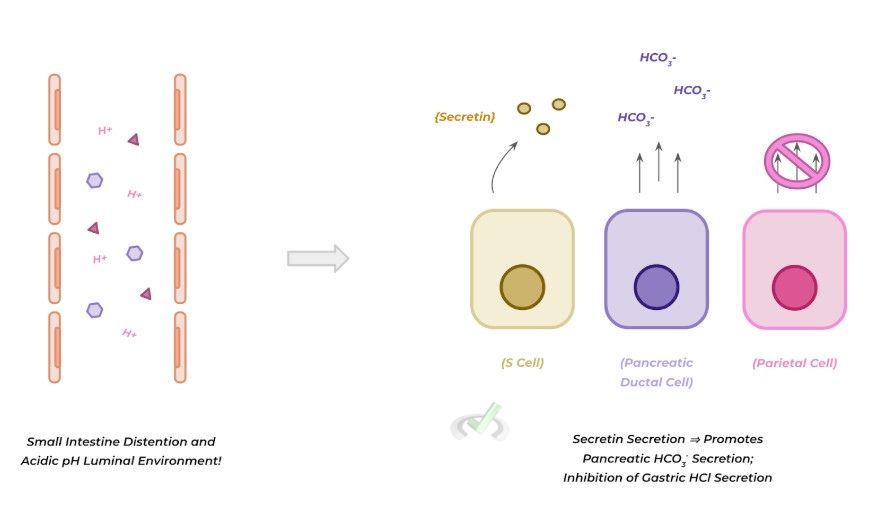
III. Cholecystokinin
Working in conjunction with secretin in regards to GI digestion, cholecystokinin (CCK) is also released at the level of the small intestine (via the I cells within the duodenum and jejunum) — it’s released in response to the presence of fatty acids and amino acids within the lumen.
CCK will stimulate the release of pancreatic fluid which is rich in digestive enzymes including pancreatic lipase, amylase, and various proteases such as trypsin (via trypsinogen precursor), chymotrypsin (via chymotrypsinogen precursor), and carboxypeptidases.
CCK will also promote the contraction of the gallbladder which will promote the release of the stored bile in the small intestine — recall that bile contains bile salts which are crucial in increasing the surface area of the incoming food particles for digestion.
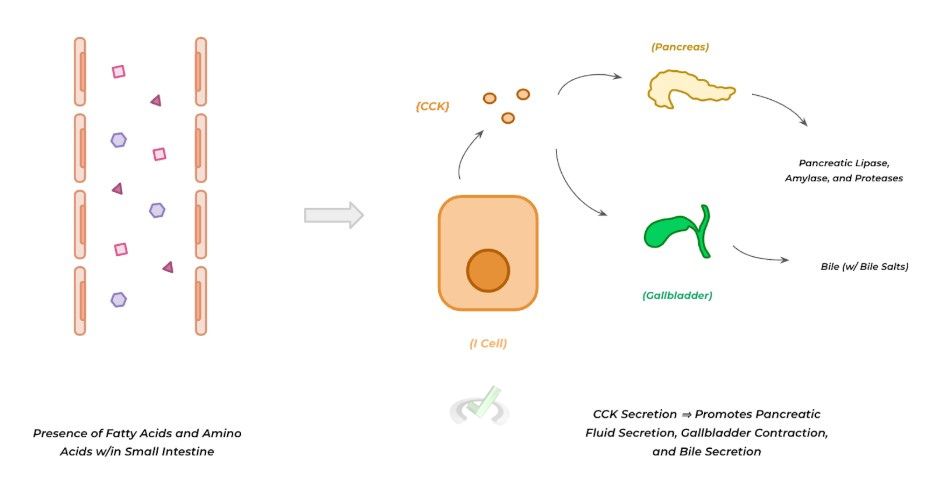
IV. Somatostatin
Finally, the other major hormone involved in the regulation of GI function is somatostatin, which is released by the delta (𝞭) cells located within the pancreas.
The action of somatostatin is really easy to remember as it simply works to inhibit processes of digestion! These include inhibiting the release of the hormones mentioned above (gastrin, secretin, CCK, etc.)
Likewise, somatostatin release should also result in the decrease in the physiological outcome of the above mentioned hormones — there should be decreased HCl and gastrin release, decreased bicarbonate release, pancreatic fluid release, etc.
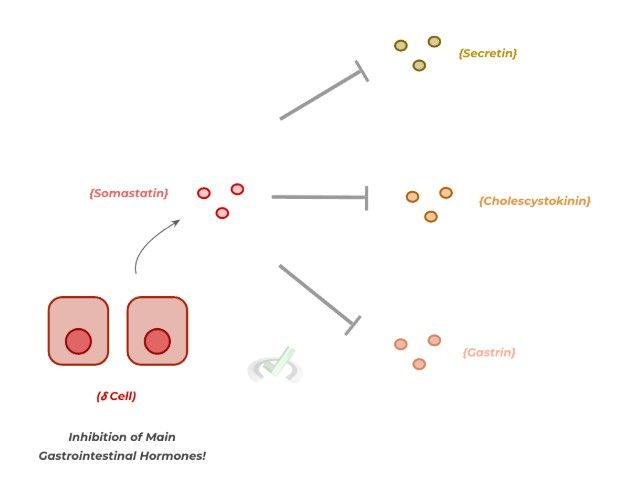
B. Neuronal Control
If you’ve covered some of our nervous system articles, you may remember us discussing the autonomic nervous system — recall this is the division of the nervous system that helps us maintain physiological homeostasis unconsciously.
Under the autonomic nervous system is a specific subdivision allocated to maintaining gastrointestinal homeostasis, called the enteric nervous system. This system is made up of various nerve plexuses within GI epithelium that control secretions and GI motility!
The activity of the enteric nervous system is under the control of both the sympathetic and parasympathetic nervous system: the sympathetic division works to INHIBIT gastrointestinal function while the parasympathetic function works to PROMOTE it.
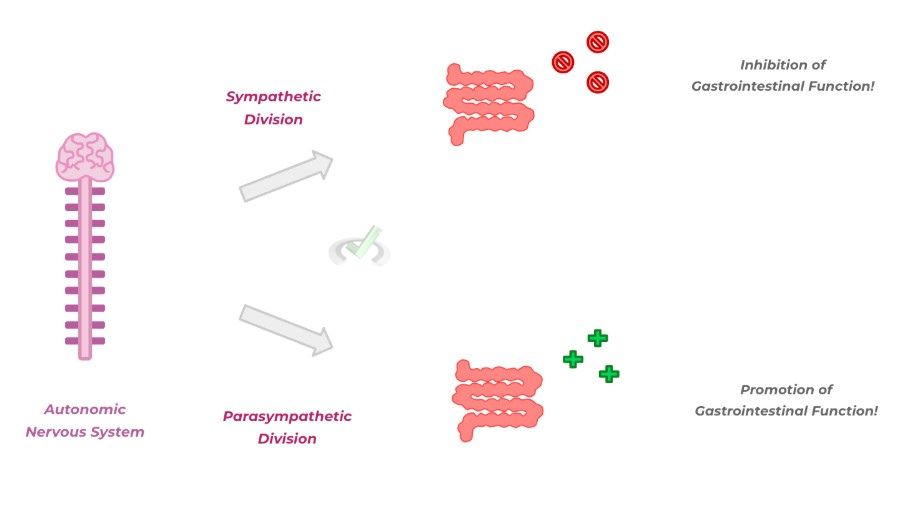
III. Bridge/Overlap
With all these different changes in pH within the lumen of the gastrointestinal tract, it’s probably best to review some of the basics of how the pH affects the activity of the various enzymes as seen in the gastrointestinal tract.
I. pH Effect on Enzymatic Function
The effect of the pH on how well an enzyme functions essentially comes down to the basics of amino acid charge. Recall that amino acids can be categorized based on the charge of their side groups — some are positively charged, negatively charged and neutral.
Changing the pH can change the protonation state of the amino acid which can also result in the changes in the amino acid charge state.
Changing a charge state can drastically change the function of the enzyme because it changes the chemical interactions of the active site and the corresponding substrate!
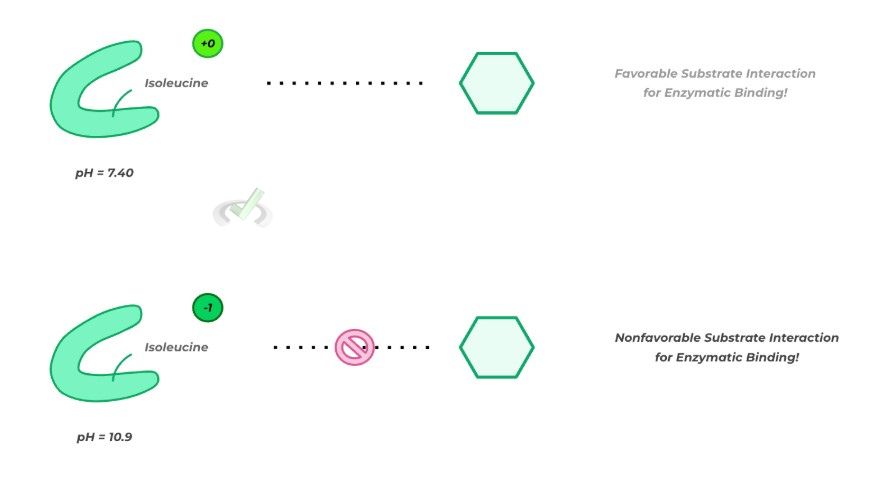
IV. Wrap Up/Key Terms
Let’s take this time to wrap up & concisely summarize what we covered above in the article!
A. Hormonal Control
Various hormones released from enteroendocrine cells within the gastrointestinal system which all have specific functions in regulating the function of digestion.
I. Gastrin
Upon the distention of the stomach and increased presence of proteins and fatty acids in the stomach, gastrin is released by the G cells of the stomach.
This GI hormone is responsible for the release of pepsin (in the inactive form pepsinogen) from the chief cells and the secretion of HCl via the parietal cells, both of which will promote gastric digestion.
II. Secretin
When the digested products from the stomach enter the small intestine, in addition to detecting an acidic pH, the S cells secrete the hormone secretin.
Secretin promotes the release of bicarbonate from pancreatic ductal cells which promotes an alkaline environment necessary for the function of the small intestinal digestive enzymes. In addition, it also results in the inhibition of HCl release.
III. Cholescytokinin
After the release of secretin, cholescytokinin (CCK) is released by the I cells which results in the contraction of the gallbladder and release of bile!
Additionally, CCK also results in the release of pancreatic fluid which contains enzymes such as pancreatic amylase, lipase, and various proteases which promotes the digestive process within the small intestine.
IV. Somatostatin
Finally, when digestion must cease, somatostatin is released from the delta cells located within the pancreas. This hormone simply inhibits the effect of the main gastrointestinal hormones we discussed above!
B. Neuronal Control
Gastrointestinal digestion and function is regulated by various nerve plexuses within the GI epithelium called the enteric nervous system — this system receives both input from the sympathetic and parasympathetic nervous system.
Under sympathetic control, gastrointestinal function is DECREASED and INHIBITED while parasympathetic control results in the PROMOTION of gastrointestinal function!
V. Practice
Take a look at these practice questions to see and solidify your understanding!
Sample Practice Question 1
A gastroenterologist is conducting research on how a particular drug will affect the pH of different parts of the gastrointestinal system. When doing a preliminary baseline conduction of a study participant, the research notices that as he passes from the stomach towards the duodenum, the pH rises from around 4.7 to 8.9. The release of the hormone which results in this rise in pH is released by which of the following cells?
A. G cells
B. Parietal Cells
C. Delta Cells
D. S Cells
Ans. D
The hormone which most likely results in this increase in pH within the small intestine is secretin, which is secreted by the S cells. Secretin stimulates the release of bicarbonate from the pancreatic ductal cells resulting in the rise in pH levels.
Sample Practice Question 2
Given a person who is simply at rest and under no stress, what would the expected gastrointestinal activity be and which neurotransmitter would be mainly involved in this process?
A. Increased, Acetylcholine
B. Decreased, Acetylcholine
C. Increased, Epinephrine
D. Decreased, Epinephrine
Ans. A
This question would be a great example of how the MCAT would ask you to synthesize and apply different pieces of information from varying fields.
As this person is simply at rest, their parasympathetic nervous system would most likely be activated as there is no imminent stress — as such, parasympathetic input would result in the promotion of gastrointestinal function! Likewise, recall that the main neurotransmitter which regulates the parasympathetic nervous system is acetycholine.


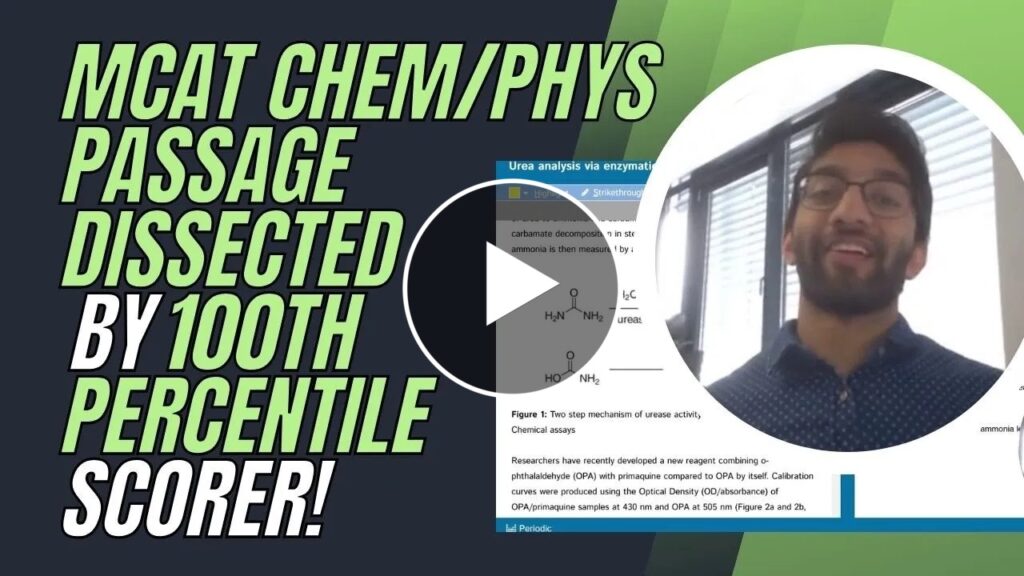




 To help you achieve your goal MCAT score, we take turns hosting these
To help you achieve your goal MCAT score, we take turns hosting these 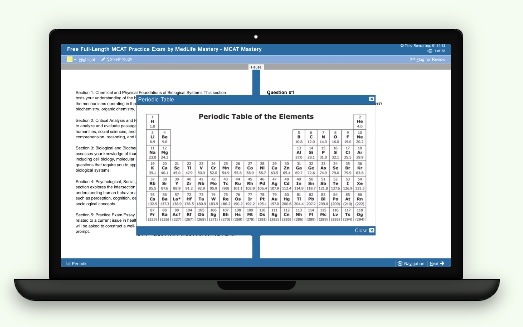





















 reviews on TrustPilot
reviews on TrustPilot